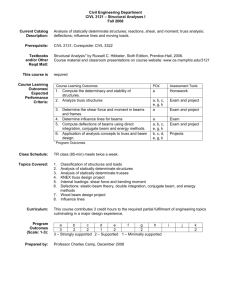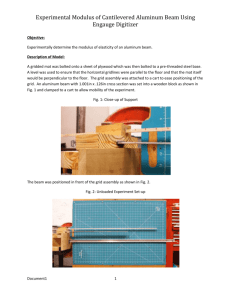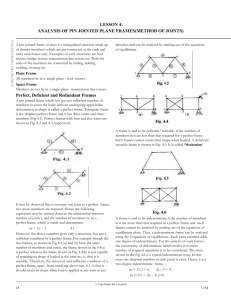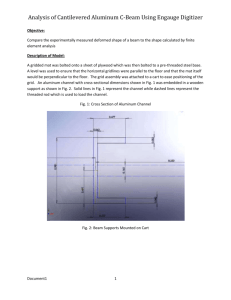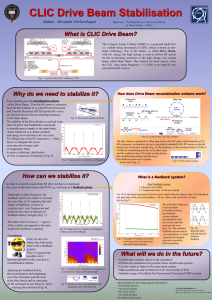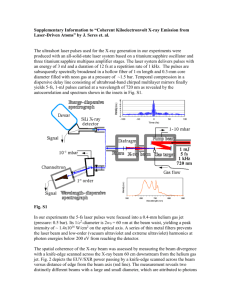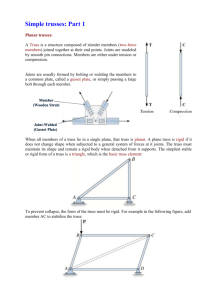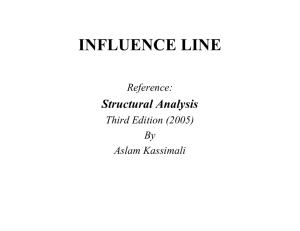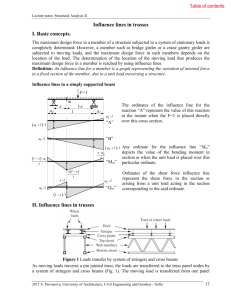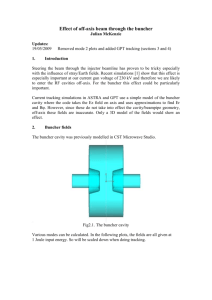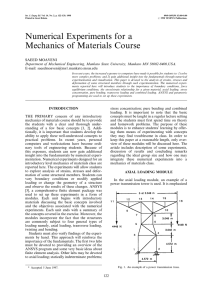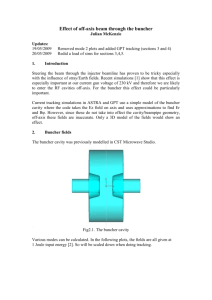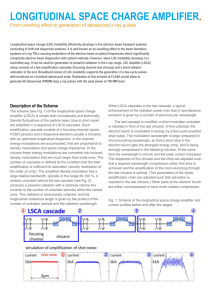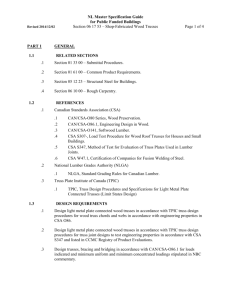Structures (II)
advertisement
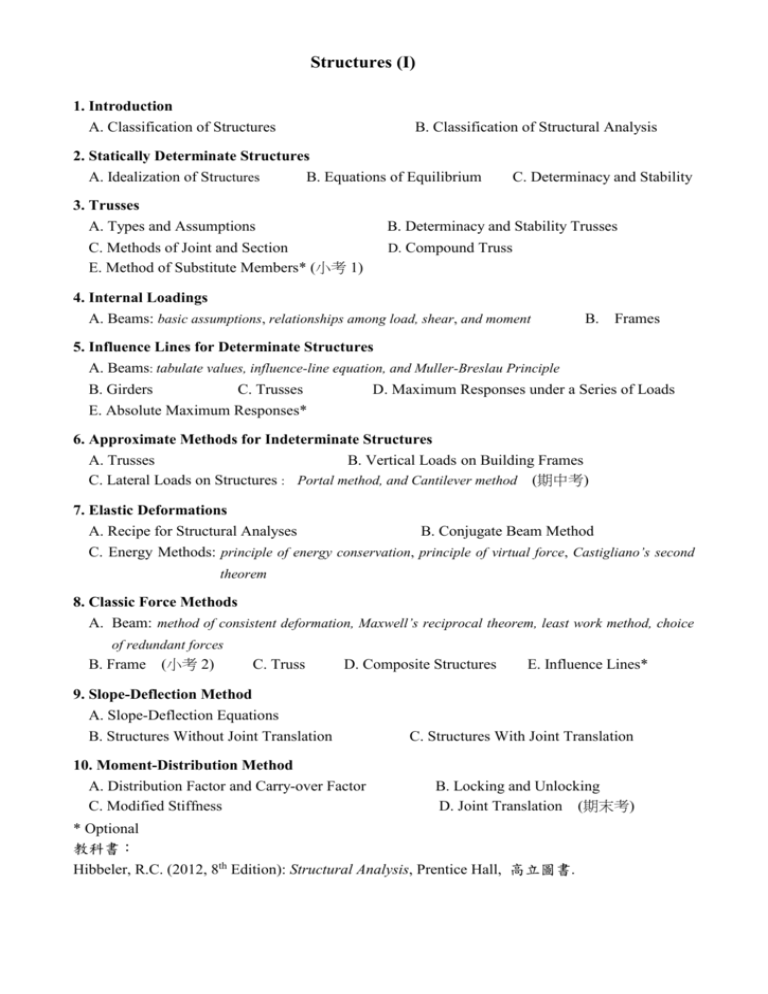
Structures (I) 1. Introduction A. Classification of Structures B. Classification of Structural Analysis 2. Statically Determinate Structures A. Idealization of Structures B. Equations of Equilibrium 3. Trusses A. Types and Assumptions C. Methods of Joint and Section E. Method of Substitute Members* (小考 1) C. Determinacy and Stability B. Determinacy and Stability Trusses D. Compound Truss 4. Internal Loadings A. Beams: basic assumptions, relationships among load, shear, and moment B. Frames 5. Influence Lines for Determinate Structures A. Beams: tabulate values, influence-line equation, and Muller-Breslau Principle B. Girders C. Trusses D. Maximum Responses under a Series of Loads E. Absolute Maximum Responses* 6. Approximate Methods for Indeterminate Structures A. Trusses B. Vertical Loads on Building Frames C. Lateral Loads on Structures : Portal method, and Cantilever method (期中考) 7. Elastic Deformations A. Recipe for Structural Analyses B. Conjugate Beam Method C. Energy Methods: principle of energy conservation, principle of virtual force, Castigliano’s second theorem 8. Classic Force Methods A. Beam: method of consistent deformation, Maxwell’s reciprocal theorem, least work method, choice of redundant forces B. Frame (小考 2) C. Truss D. Composite Structures E. Influence Lines* 9. Slope-Deflection Method A. Slope-Deflection Equations B. Structures Without Joint Translation 10. Moment-Distribution Method A. Distribution Factor and Carry-over Factor C. Modified Stiffness C. Structures With Joint Translation B. Locking and Unlocking D. Joint Translation (期末考) * Optional 教科書: Hibbeler, R.C. (2012, 8th Edition): Structural Analysis, Prentice Hall, 高立圖書. 2014 年 01 與 02 班成績分佈(共 95 人) A 22 人(22.2%),B 24 人(24.2%),C 24 人(24.2%),F 29 人(29.3%), Average 67.73 , standard deviation 14.41, median 68. Through the performance of a goodness-of-fit test, the distribution of grades is confirmed to be normal. mean 67.73 deviation student 14.41 2014.6 99 probalility expected observed chi-square A+ 95 91.0 0.9468 0.0532 5.26 7 0.573 A 87 84.5 0.8777 0.0691 6.84 7 0.004 A- 82 80.0 0.8028 0.0750 7.42 8 0.045 B+ 78 76.5 0.7286 0.0741 7.34 8 0.059 B 75 72.5 0.6297 0.0989 9.79 8 0.328 B- 70 69.0 0.5351 0.0946 9.36 8 0.198 C+ 68 66.5 0.4660 0.0691 6.84 8 0.195 C 65 62.5 0.3583 0.1077 10.66 8 0.663 C- 60 57.5 0.2389 0.1194 11.83 8 1.237 F 50 0.0 0.0000 0.2389 23.65 29 1.211 1.0000 99 99 4.514 19.5 26.5 53.0 14.067 critical NATIONAL TAIWAN UNIVERSITY Structural Theory (Ⅰ) Department of Civil Engineering Spring 2014 1st Quiz: 09:10~10:10am, March 18 (Tuesday), 2014 1. Classify each of the structures as statically determinate, statically indeterminate, or unstable. If indeterminate, specify the degree of indeterminacy. (20%) (未說明理由不計分) (a) Beam (b) Frame (c) Truss (d) Truss 2. Determine the reactions at the pin supports A and B. The joint at D is pin connected. (25%) 3. Determine the force in members CB and CA, indicate whether these forces are tensile or compressive. Assume A is pinned and B is a roller. (25%) 4. Determine the force in members IH, AH, and BC of the truss. State if the members are in tension or compression. (30%) 6 kN NATIONAL TAIWAN UNIVERSITY Structural Theory (Ⅰ) Department of Civil Engineering Spring 2014 2nd Quiz: 09:10~10:10am, May 20 (Tuesday), 2014 1. Use the conjugate-beam method to determine the slope at B and the displacement at C. EI is constant. (30%) M A B L C L L 2. Determine the vertical displacement of joint F of the truss shown below. Take EA 3 106 kN for each member. (35%) E F P = 300 kN C 5m D A B 5m 5m 3. Use the force method to determine the reactions at the supports A, B, and C. EI is constant. You can make use of the result from Prob. 1 if you need. (35%) M A B L L C L Final Examination: June 19, 2014 Note: No credit will be given in each problem if the procedure is not based upon the requested methods. 1. The length of member 23 of the truss shown in Figure 1 is 5.01m due to fabrication error. Use the force method to determine the member forces of 24 and 34, F24 and F34 . Note that that E = 200 Gpa, A = 5 cm 2 for all members, and L = 5m. (20%) 2 3 L 2P P 1 4 A B C 2EI, L L EI, L Fig.1 D EI, L/2 Fig.2 2. (a) Use the slope-deflection method to determine end moments M AB , M BA , and M BC of the beam shown in Fig.2. Load P is applied at the middle of BC. Your solution must be expressed in terms of E, I, L and P. (15%) (b) When E = 200 Gpa, I = 2.5 × 10 4 cm 4 , L = 5m and P = 44kN, draw the shear and moment diagrams of this beam(10%) 3. Use the slope-deflection method to determine the rotation at C, C . E I of the frame is constant. Your solution must be expressed in terms of E, I, L and P. B (15%) C L, I P L, I P L, I w A A D Fig.3 B L C L D 0.75L Fig.4 4. Use the moment distribution method to determine all end moments of the beam shown in Fig.4. E I of the beam is constant. Note that P = 48 kN, E = 200 Gpa, I = 1.25 × 10 4 cm 4 and L = 4m. 5. (a) Refer to the beam in Fig.5a. The distributed load w = 5.5 kN/m, L = 8m, E = 200 Gpa, and I = 4.5 × 104 m 4 . Use the moment distribution method to determine M AB , M BA , and M BC . (10%) (b) Refer to the beam in Fig.5b. The distributed load w = 5.5 kN/m, L = 8m, E = 200 Gpa, and I = 4.5 × 104 m 4 . Use the moment distribution method to determine M AB and displacement at C. (15%) w B w C B C EI, L EI, L 2EI, L 2EI, L A A Fig.5a Fig.5b

